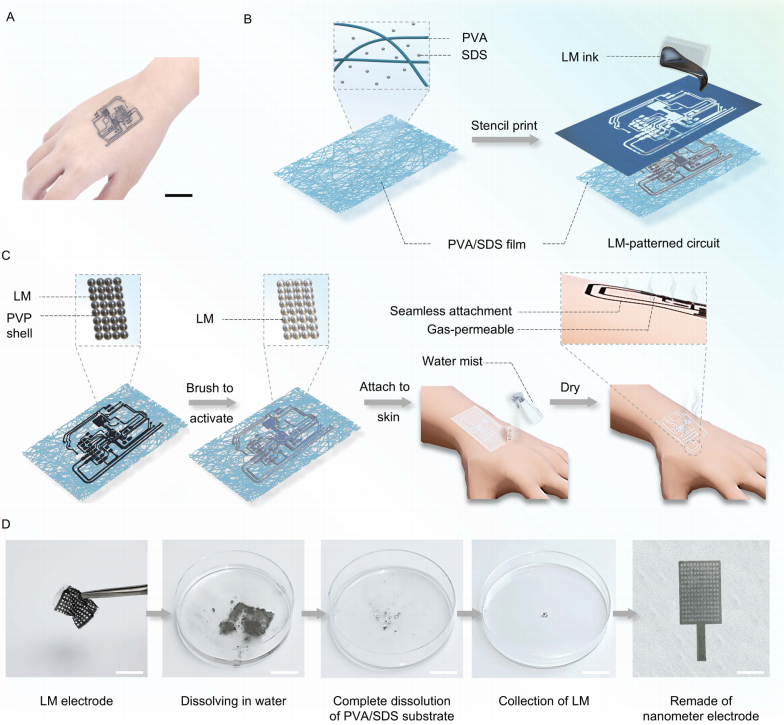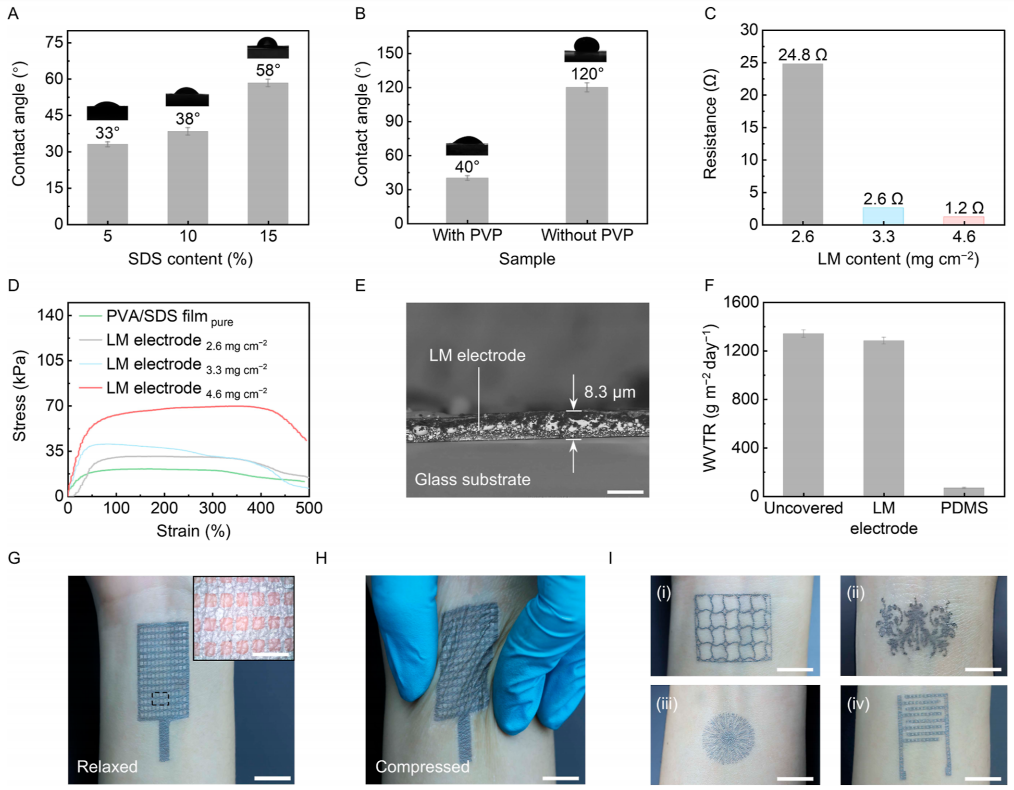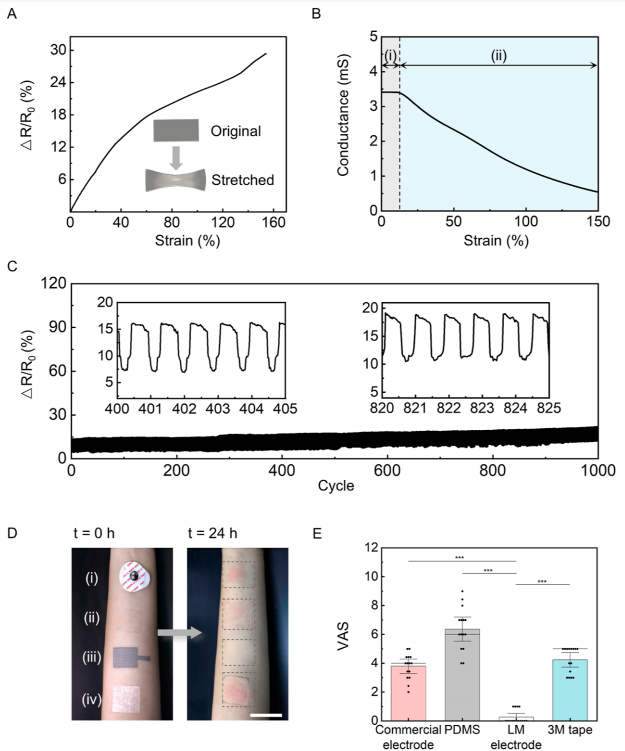
点击蓝字 关注我们

欢迎各位专家学者在公众号平台报道最新研究工作,荐稿请联系小编Robert(微信ID:BrainX007); 或将稿件发送至lgl010@vip.163.com。
英文标题:Conformal, Substrate-Free Liquid Metal Electrode for Continuous Health Monitoring

成果简介
柔性电子在连续、实时监测多种生理信号方面取得了显著进步,实现了主动医疗和个性化治疗。超薄、贴合皮肤的柔性电子器件是皮肤无缝集成的理想选择,可实现高保真健康监测和先进的人机交互。然而,传统材料和设计方法难以同时满足透气性、高导电性和贴合性的多重需求,因此实现无感、无缝的粘附仍是一大挑战。为了应对这些挑战,干电极,尤其是采用金属纳米材料、碳纳米材料、导电聚合物以及液态金属(LM)等先进材料的干电极,已经引起了广泛关注。LM由于其优异的电导率、出色的流动性和生物相容性脱颖而出。这些特性使LM电极即使在机械应力和复杂的环境条件下也能保持优异的性能,相比传统的固态电极,具备更强的信号稳定性与鲁棒性。
本研究提出了一种简便高效的设计方案,用于制备超薄、无基底、高透气且导电的液态金属(LM)电极。该电极可借助由聚乙烯醇(PVA)与十二烷基硫酸钠(SDS)构成的电纺纳米网,通过水雾溶解的方式直接贴合在人体皮肤上。电极厚度仅为8.3 μm,导电率高达4.2 × 106 S m-1,透气性能为1283.8 ± 27.7 g m-2 day-1。24小时皮肤贴敷测试表明,该表皮电极未引起任何皮肤刺激反应。此外,该电极还具备优异的可定制图案化能力与可回收性。在实际应用中,该电极能够无线采集高保真电生理信号,即使在睡眠、电脑办公、行走等日常活动中也能稳定工作。该研究为长期可穿戴健康监测提供了一种极具前景的解决方案,在早期疾病检测、远程健康监护与个性化医疗等领域具有广阔的应用潜力。
研究亮点
无基底设计:通过水雾溶解PVA/SDS临时基底,使LM电极直接贴合皮肤,无需额外粘合剂或固定层,避免传统基底的限制与不适感。
高透气性与可回收性:透气性能高达1283.8 ± 27.7 g m-2 day-1,并且能够通过NaOH溶液去除LM表面氧化物,实现92%金属回收率,支持电极的循环制备与使用。
图文解析

Fig.1. (A) Photograph of LM electrode adhered on skin seamless without additional fixation. Scale bar, 2 cm. (B) Schematic illustration of the fiber structure and screen-printing process. (C) Schematic illustration of the activation and attachment process for gas-permeable LM electrode, demonstrating its excellent adaptation and conformability to skin after substrate dissolved by water mist. (D) Photographs of the recycling process of flexible LM electrode. Scale bar, 2 cm.

Fig.2. (A) Influence of SDS content on contact angle of fibers prepared with 10 wt % PVA, illustrating the enhanced surface wettability by SDS. The inset shows the contact angle images during measurement. (B) Comparison of contact angles for LM ink on fibers with and without PVP. The inset displays the contact angle images of the ink on PVA/SDS nanofiber membrane. (C) Influence of LM content resistance on LM ink. (D) Tensile stress−strain curves of pure PVA/SDS film and the electrodes with different LM content. (E) Cross-sectional SEM image of LM electrode on a glass substrate. Scale bar, 10 μm. (F) Comparison of water vapor
transmission rate (WVTR) for an uncovered bottle, a bottle covered with ∼8 μm-thick LM electrode, and a bottle covered with 1 mm-thick PDMS film, respectively. (G) Photograph of LM electrode attached on a female wrist in a relaxed sate. Scale bar, 1 cm. The inset is a magnified view of the LM electrode. Scale bar, 500 μm. (H) Photograph of LM electrode attached on a female wrist in a compressed sate. Scale bar, 1 cm. (I) Photographs of various LM patterns printed on wrist: (i) bend matrix, (ii) lantern, (iii) firework, (iv) interdigital electrode. Scale bar, 1 cm. Error bars represent the standard deviation (SD) of the measure values (n = 3).

Fig.3. (A) Normalized resistance versus tensile strain for LM electrode. (B) Conductance-strain characteristics of LM electrode laminated onto 10%-prestretched PVA/SDS film. In region (i), the applied strain is smaller than prestrain. In region (ii), the applied strain is larger than prestrain. (C) Durability test of cyclic stretching/releasing for 1000 cycles at 30% strain. (D) Skin biocompatibility test with different samples: (i) commercial electrode, (ii) PDMS, (iii) LM electrode, and (iv) 3 M tape. Scale bar, 5 cm. (E) Participants discomfort ratings for commercial electrode, PDMS, LM electrode, and 3 M tape attached on skin, evaluated using the visual analog scale (VAS) (VAS, 0−10); crosses represent the mean, and error bars represent the SD of the measure values (n = 15).

Fig.4. (A) Skin-electrode contact impedance of commercial electrodes and LM electrodes. (B) EMG signals recorded by LM electrodes and commercial electrodes during a grip test in its initial state. (C) SNR of EMG signals monitored by LM electrodes and commercial electrodes. (D) Schematic illustration of the wireless ECG measurement experimental setup. (E) Comparison of ECG waveforms recorded over 15 s by LM electrodes and commercial electrodes. (F) SNR of ECG signals monitored by LM electrodes and commercial electrodes. (G) Continuous ECG signal monitoring (bottom) and heart rate data (top) using the LM electrodes during various daily activities from 13:00 to 16:00, the top showing zoomed-in signal segments.
研究结论
本研究通过静电纺丝与丝网印刷技术,成功制备出一种无基底、可穿戴、超薄、透气且亲肤的电极。该电极利用柔性多孔PVA/SDS基底上形成的液态金属(LM)导体,兼具高导电性与流动性,可实现高分辨率、可定制的图案结构。该电极在皮肤日常形变下仍具备优异的电性能与粘附力。PVA/SDS基底可通过水雾溶解,使电极牢固贴合皮肤,即使在曲面也能保持共形接触。该电极能够实现连续3小时以上的无线心电监测,验证了该电极在日常环境下长期采集生理信号的能力。此外,LM电极的可定制特性为个性化健康监测设备的发展带来重大突破,为未来无线医疗技术的创新奠定基础。研究充分展示了该LM电极系统在柔性电子及生物医学应用中的广阔前景。
免责声明:原创仅代表原创编译,水平有限,仅供学术交流,如有侵权,请联系删除,文献解读如有疏漏之处,我们深表歉意。


公众号丨智能传感与脑机接口
